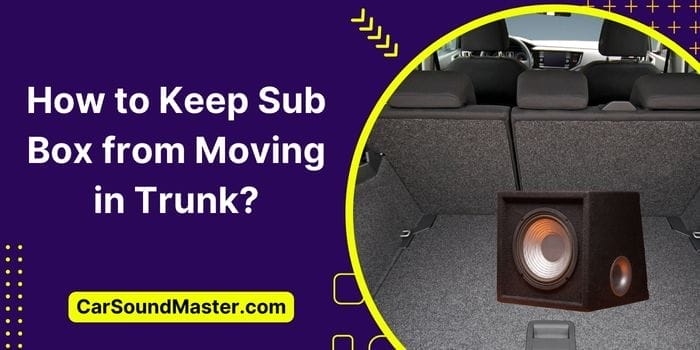How to Keep Sub Box from Moving in Trunk? Simple DIY Tricks
Bulky bass is a nonpareil feeling; bigger subs are have-it-all, and there are no two ways about both these things.
But just for a moment, imagine yourself in a roadside tailgating competition – going hard, corner hard, and changing gears in milliseconds.
What’s the last thing you’d want to happen now (maybe as a curse to those chirpy moments)? Your sub box getting dislodged, sliding around the trunk, and hitting here and hereabouts, right? I know I guessed it right.
Subs are great but their bigger, cabinet-closed constructs have this one downside – and a mighty downside, I’d say. Unless you learn how to keep sub box from moving in the trunk and finally do it up, it will keep smashing all around and frustrating you during those hilly or bumpy drives.
Anyway, you don’t need to worry a bit about that. This guide is gonna teach you all the possible ways you can keep your subwoofer box from sliding around.
Keep scrolling!
Why Does Subwoofer Not Stay Put in Place?
Before we move on to the main topic, let’s first briefly check out why subwoofers happen to bring such unusual worries with them.
Well, unlike the other speakers in your car that radically go into doors, dash, pillars, or stick onto shelves, enclosed subs merely freely sit into your car’s trunk just like anything – a first aid kit, a flashlight, a lug wrench, tire jack, etc.
Now because subs are specialized in only the bass region of sounds, there is so much of the vibration element involved which ultimately displaces the sub, more so often if:
- The subwoofer cabinet is poorly installed, unbalanced, and not evenly poised or properly secured to the floor
- The enclosure is a cheap one made out of a flimsy, lightweight material
- Your car has no proper boot liner or friction-supporting carpeted flooring
That said, make sure your sub cabinet is placed on a proper anti-slip floor covering and the surface is evenly flat throughout under the box. This will significantly minimize all such and related issues with your subwoofer, but if not, try the following fixes.
How to Keep Sub Box from Moving in Trunk?
There are numerous methods you can successfully secure your subwoofer box from moving around in your car’s trunk. For instance:
#1. Velcro Your Subwoofer to the Trunk’s Floor
The least invasive and most economical of the methods to make your subwoofer stay put in place is using the Velcro fasteners (get either a long tape roll or a few little circles). But for this to work, you’d need to make sure your trunk has carpeted flooring. Then, follow these steps:
- Get an industrial-strength Velcro fastener and cut it into four strips to go around the perimeter of your subwoofer box.
- Take only the “hook” sides of the tapes and put them to the underside of the box on all four sides using, maybe, a staple gun.
- Put the “loop” side of the Velcro onto the floor’s carpet in the exact place where you want your subwoofer to sit.
The hook side of the Velcro though may easily clasp to the carpet itself, putting the loops onto the carpet may make for a much-improved grip.
Velcro fastening is one of the best solutions and highly recommended in such scenarios as with them, you can easily tweak your sub’s placement and effortlessly put it on and off if/when needed.
In addition, if you feel like the carpet on your MDF flooring is also not firm, you can try installing an extra piece of rug right under where the sub box sits at the floor, and Velcro both the main carpet and that extra rug using tape or circular hook-and-loop pieces.
Or Try Double Sided Tapes
Installing double tapes is almost the Xerox of Velcro fastening, though, depending on their strengths, a quality double-sided tape may offer a much stronger hold. That being said, they will be a bit of a struggle to remove as well, later on.
Anyway, if you prefer going with double tape, for better results, make sure the surfaces of your sub box and trunk’s floor are washed with rubbing alcohol and free of any filth before you stick the tape onto them.
After sticking the tapes and putting the speaker into place, ensure it stays pressed and unmoved for an hour or so to get solidly firm.
#2. Get Your Subwoofer an Anti-Slip/Non-Skid Mat – May Only Work for Heavier Subs
As their name suggests, anti-skid mats are specially designed pads to prevent those icy slips and falls. Not only do they help secure your subwoofer from sliding but also work as, sort of, cushioning between the sub and the car’s body.
That also helps in eliminating the overall vibration effects caused by bass-heavy punches of the sub and reduces the minor pulsations felt in the car. Make sure you get one with suitable dimensions to effectively accommodate the sub.
What About a Pad or Rubber Feet?
Putting rubber feet on the edges of your subwoofer cabinet might also be a multi-functional fix. It could help with securing the subwoofer’s placement, serve as insulation between the sub and trunk’s floor, and may also prevent your trunk’s interior from scratches caused by movements of the subwoofer box.
#3. Using Ratchet Belts or Bungee Cords
Though quite unprofessional and drab, using ratchet belts or bungee cords is another quick, economical, DIY fix regarding how to secure subwoofer box in trunk.
All it involves is simply placing the subwoofer in your desired place in the trunk and tying it tight to the nearby anchor points. For instance, one of those tie-down flecks or cargo hooks inside the boot.
Finally, double-check the stretch and tension making sure it’s enough to keep the cabinet well and firm in place.
There is, however, a difference between ratchet straps and bungees in how they work, their application is almost the same. In automobiles manufactured after the 2000s, the LATCH system may also somehow serve this function.
#4. Mounting Subs with L-Brackets
Mounting brackets hold the same importance for a subwoofer as for the other speakers on your car; they make the speakers and sub sit well and secured in one place.
Brackets have so many other benefits as well, for example, improving the safety of cabinets or helping with organized wiring schematics – just what the L-brackets do the best.
To install L-brackets, here’s what to do:
- Start by measuring the length and width of the subwoofer enclosure
- Choose the place where you want to keep the sub and do the necessary markings
- Get a drill machine and make holes along the marks as and where required per the bracket
- Attach the bracket to the floor with the help of screws and nuts
- Take the subwoofer, put it into the place aligned with the bracket, and fit the box to the bracket via nuts and bolts. Tighten them to ensure a secure fit.
On the other hand, you can also try mounting the bracket to the subwoofer box first and then attaching the setup altogether to the car’s trunk.
How About Securing the Subwoofer Using Metal (or Wood or Wood-to-Metal) Fasteners?
This, again, is almost the same thing in application as brackets. Metal fasteners can be any steel screws or small L-shaped (right-angled) metal fillets with holes for screws to go into materials to make a fit. Wood fasteners are also screws but with coarse threads majorly intended for wood-related uses.
So when thinking about how to keep sub box from moving in trunk, you can give them both a good try as well.
For that, you need to put your subwoofer in your desired place in the trunk and simply drill the fasteners into the wooden board along the cabinet’s girth – maybe 2 on each side would be enough.
The better option, though, is to push the sub’s cabinet to the uttermost left/right corner where it gets support from the seat on its backside and also from the car’s body at one of its sides.
That way, you’d need to put a couple of nails on two sides only to secure the sub in one fixed place.
#5. Permanently Fixing/Bolting Down the Subwoofer in the Trunk
Drilling holes in your car is never recommended as it may cause some big damage, but it certainly is a last-act fix when everything else fails to work.
Bolting down the subwoofer to the car’s body itself means a permanent incarceration (unless you screw it open, again).
This method doesn’t mean that you should be drilling holes in the trunk itself (which isn’t impossible; just not a good go-to option) but in the insulating material between the trunk and the subwoofer – an MDF board, in most cases.
In case of no wooden floor in your car, you should first build one which is a completely different story. But let me suppose your car has a wood board therein, so here’s what you should do next:
- Find the best place for your subwoofer where it would perfectly sit without any imbalances and interference with other miscellany
- Open up your sub’s cabinet and take out the speaker driver, cone, etc.
- Drill one hole near each of the corners on your cabinet’s underside, and map the holes right onto the wooden board via a pen
- Drill the MDF board, flip it upside down, put the bolts into the holes, and hammer them in until they fully pierce through
- Flip the board back, and place the subwoofer cabinet right onto the extruding bolts through the holes drilled in Step 3
- Tighten the nuts on the bolts coming out of the wooden plank as well as the subwoofer cabinet’s holes using a spanner
- Redo your cabinet by putting the speaker components back in. That’s it!
The method is, however, a full-proof fix, it’s still easier said than done and requires a lot of time and resources. In the process of drilling holes, you may also end up damaging your cabinet or your car in an absolutely bad manner.
Also, the next time you need to tweak or take off your subwoofer, you’ll need extra hours to unscrew and uninstall the setup.
Final Thoughts
A poorly placed speaker can have so many negative impacts on your music moments with severe distortions and increased noise. It can also result in damage to the trunk and the rest of the stuff, and can even injure the enclosure itself.
Hence, securing the subwoofer box from moving around in the trunk is as essential as anything. As described above, there are so many ways to do that.
One more (but quite unheard-of) fix to that issue is getting a neo-magnetic quick-release enclosure placed on a same-sized metallic/steel plate inside the trunk.
The magnets in the box and the steel plate create a strong bond between them keeping the sub stay put firmly in place.
With that, I hope you’ve learned more than enough re. how to keep sub box from moving in trunk. If there’s anything more I can help you with, let me know in the feedback section.







